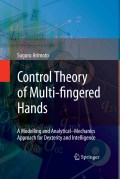
Control theory of multi-fingered hands: a modelling and analytical-geometry approach for dexterity and intelligence
Arimoto, S.
The hand is an agency of the brain; it reflects activities of the brain and thereby can be seen as a mirror to the mind. The dexterity of the hand has beeninvestigated widely in developmental psychology and in anthropology. Since robotics launched in the mid-1970s, numerous multi-fingered hands mimicking the human hand have been designed and made in a number of universities and research institutes, in addition to sophisticated prosthetic hands with plural fingers. Control Theory of Multi-fingered Hands presents a comprehensive insight into the intelligence and dexterity of robotic multi-fingered hands from both thephysical and control- theoretic viewpoints. Control Theory of Multi-fingered Hands will be a useful reference for postgraduate students and researchers in this field, as well as engineers and roboticists. No other book has been written about the control of multi-fingered hands. Explains what kinds of sensory-motor coordinated signals are necessary and sufficient for realizing stable grasping and/or object manipulation INDICE: Characteristics of Human Hands.- Stability of Grasping in a Staticor Dynamic Sense.- Test-bed Problems of Control: How to Stabilise 2D Objects through Rolling Contact.- Two-dimensional Grasping by a Pair of Rigid Fingers.- Three-dimensional Grasping by a Pair of Rigid Fingers.- Dexterity and Control for Stable Grasp by Soft Fingers.
- ISBN: 978-1-84800-062-9
- Editorial: Springer
- Encuadernacion: Cartoné
- Páginas: 275
- Fecha Publicación: 01/02/2008
- Nº Volúmenes: 1
- Idioma: Inglés
